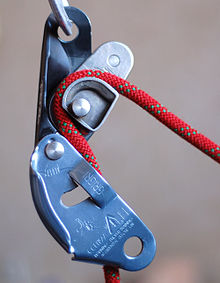Grigri (climbing)
This article needs additional citations for verification. (February 2013) |
Some of this article's listed sources may not be reliable. (February 2013) |



A GRIGRI (often styled as GriGri) is an assisted braking belay device manufactured by Petzl designed to help secure rock-climbing, rappelling, and rope-acrobatic activities. Its main characteristic is a clutch that assists in braking under a . The success of this device has led to grigri becoming a common name for devices of this type. In 2011[1] a new version, the GRIGRI 2, was released to replace the original 1991 model.[2] Petzl released the GRIGRI + in 2017, adding safety features to the original design, and 2019 saw the release of an updated version of the device, simply called the GRIGRI.
Mechanism of operation[]
The GRIGRI works by pinching the rope when it is moving quickly (like in a fall), making it an . This function distinguishes it from traditional belay devices such as a Sticht plate or an ATC, whose braking mechanisms depend entirely on the user controlling the rope in a specific manner to increase or decrease friction. Inside the GRIGRI, the rope runs along a cam; the cam allows the rope to pass if moving slowly but rotates when the rope moves more quickly, blocking further movement by pinching the rope against the inside of the device.
Uses and limitations[]
Petzl recommends the device for lead belaying and top-rope belaying.[3]
When used correctly, the GRIGRI's camming mechanism can assist in holding a climber that is working a route, or hanging on the rope while trying to figure out a climb. When belaying, the same technique for "taking in" that is used with an ATC or similar device is used. While paying slack out into the system, if the device is held open and the climber falls, the device will not lock unless the belayer stops holding it open.
Each generation of the GRIGRI has a lower limit for the rope diameter for which the cam will engage; the manufacturer recommends the Grigri2 to be used only with 8.9 to 11 mm diameter ropes.
This device has just one place for installing rope and it can't be used in climbing with half rope.
This device is not suitable for left-handed belay technique. There is a sharp edge on the side that will fray rope if used left-handed, but a smooth flange to protect the rope while belaying right-handed. However, there are special techniques that allow left-handed belayers to use this device, like reorienting it to face the other way.[4]
Operating instructions[]
Incorrect operation[]
- The release handle is pulled without holding on to the braking side of the rope.
- The GRIGRI is held in one hand. As a consequence, the GRIGRI cannot move without restriction and the blocking mechanism cannot function.
- The belayer operates the release handle incorrectly, lowering the climber too quickly. Under these circumstances, there is a risk that the belayer might panic and pull the handle farther back, causing an even more rapid descent for the climber. This risk is mitigated in the GRIGRI +, which was designed with an "anti-panic" feature that re-engages the cam if the belayer holds the handle open.
- The brake hand leaves the braking side of the rope at any time, including while the GRIGRI is locked. The blocking mechanism does not work in all cases without reinforcement.
- The rope is installed incorrectly. This will lead to the blocking mechanism failing.
Correct operation[]
- Before climbing, a partner safety check is performed.
- The braking hand always holds on to the braking side of the rope.
- Taking up and paying out slack is primarily done with the same methods as those developed for tube-style belay devices.
- Giving slack quickly to the leader is done using the “Gaswerkmethode” or "Gaswerk technique" (a method originally developed in a climbing gym called “Gaswerk” to enable dynamic belaying with the GRIGRI).
- Proper belay technique is observed with regard to managing slack, proper belayer positioning in relation to the rock, etc.
- When lowering the climber, the braking hand holds on to the braking side of the rope while the leading hand gradually releases the blocking mechanism by pulling the release handle carefully. The braking hand supports the regulation of lowering the climber.
The correct operation of the GRIGRI should always be learned and trained under qualified supervision.
Big wall use[]
While the GRIGRI was designed as a belay device, some big wall climbers (such as those climbing Yosemite's Half Dome or El Capitan) have invented novel ways to extend its use and compromise its safety. For example, some big wall rope soloists use the GRIGRI (sometimes slightly modified) as a self-feeding hands-free self-belay device. It has also seen use by the second to self-belay while jumaring the rope as one half of the ascender pair. The manufacturer holds uses outside of those validated come with considerable risks, and its official documentation goes so far as to expressly prohibit certain uses.[5]
Parts of the GriGri and GriGri+[]
There are seven parts that the GriGri and the GriGri+ have in common.[6]
- Moving side plate
- Cam
- Cam axle
- Friction plate
- Handle
- Fixed side plate
- Attachment holes
The GriGri+ has two additional components:
- Selector knob
- Lock button
References[]
- ^ "Petzl Grigri 2 to be Released in the USA in March - Climberism Magazine". www.climberism.com.
- ^ http://www.petzl.com/en/outdoor/belay-devices-and-descenders
- ^ "GRIGRI 2 - Petzl".
- ^ https://climbingblogger.com/how-to-belay-left-handed-using-grigris/ How to Belay Left-Handed Using Grigris
- ^ "Self-belaying is prohibited! - Petzl USA". www.petzl.com. Retrieved 2019-10-11.
- ^ "Nine Parts of the Petzl GriGri Belay Device". Outdoor Rack Builder Blog (in American English). 2020-10-28. Retrieved 2021-01-15.
External links[]
| Wikimedia Commons has media related to Grigi. |
- Caving equipment
- Climbing equipment
- Mountaineering equipment